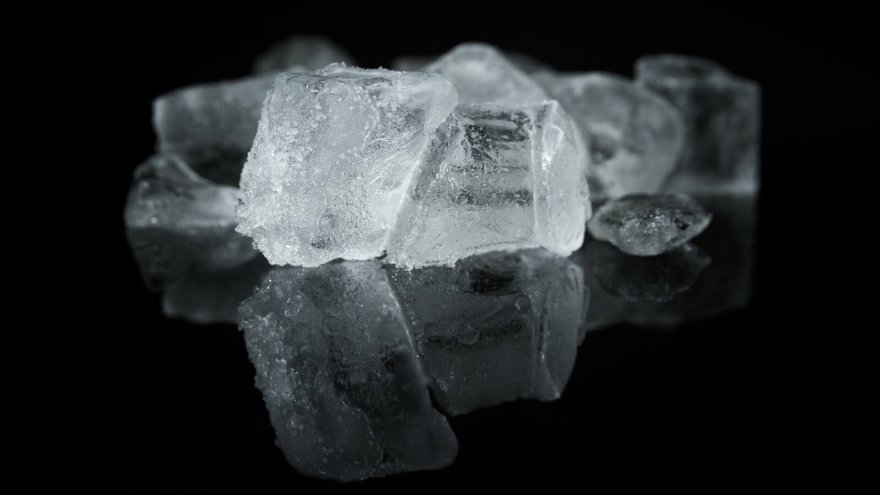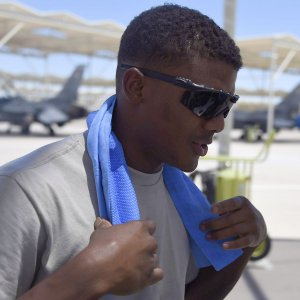Do Cooling Towels Really Help You Keep Cool?


I love hot weather. And for the most part, I don’t mind exercising in the heat once I have become acclimated to it. On those days when I can’t run in early in the morning or in the late afternoon/early evening and I have to run in the heat of the day, I have a trick to help me keep cool.
I take a cotton bandana, fold it in half into a triangle, line the long side with ice cubes, roll it up and tie it around my neck. I have only gotten one honk/”nice scarf” comment and little did they know that the slowly melting ice was making my mid-day run bearable.
Recently though, I was given three cooling towels, which brings my total up to five. I used one a couple of years ago after a run but since I didn’t notice any great benefits, I tucked it back in the closet. Maybe I didn’t use it properly or maybe it is of low-quality fabric or maybe cooling towels don’t really work. With the heat of summer in the offing, I thought cooling towels might be worth a little more exploration than my first attempt.
The greatest thing since sliced bread?
Those selling and/or marketing cooling towels would have you think that they are something you shouldn’t be without, particularly if you live in a hot climate or work out of doors during the heat of the day. They are marketed for everything from exercise, fishing, camping, trips to the beach and amusement parks to yard work, gardening, and jobs that require employees to be outside in the heat such as construction workers, lifeguards, and professional athletes.

How do cooling towels work?
These towels come in a large array of sizes, colors, and different types of fabrics, all made to absorb and retain water well.
All cooling towels employ evaporative body cooling, which is the mechanism the body uses to stabilize temperature. When we sweat, the body sends liquids to the surface of the skin. Changing this liquid into a gas (evaporation) requires energy from the body and in this case, it takes the form of heat. This transfer of heat facilitates evaporation results in a cooling effect on the body.
So, when you wet a cooling towel and wrap it around your neck, the water in the towel evaporates, decreasing the temperature of the towel. This decrease in the towel’s temperature is transferred to the body, lowering the body’s temperature so you feel cooler.
It is the same process that my ice-in-the-bandana trick utilizes except in my case, the ice has to start melting before the water can begin evaporating.
The big difference between my bandana and the cooling towels is the fabric. Cotton bandanas are relatively thin and can only soak up so much water. Cooling towels use fabrics that are designed to hold more water and to hold it better and to regulate how quickly the water evaporates.
So it seems that based on the fact that they utilize the evaporation cooling process and that they are designed to efficiently store and release water, cooling towels should be in every athlete’s gym bag.
And scientific research seems to bear that out, not exactly endorsing marketed cooling towels but proving that the process does keep the body cooler.

Science supports it
For instance, in a study that simulated tennis match played in hot and humid conditions, researchers affirmed that an ice-filled damp towel around the neck and a cold, damp towel on the head and thighs (ICE strategy) successfully diminished thermal strain during play under those conditions. The ICE strategy is frequently used in professional tennis during changeovers between play. The study, “In-Play Cooling Interventions for Simulated Match-Play Tennis in Hot/Humid Conditions,” was published in the May 2017 issue of Medicine and Science in Sports and Exercise.
A similar study titled “Optimal cooling strategies for players in Australian Tennis Open conditions,” and published in the March 2018 issue of the Journal of Science and Medicine in Sport, came up with similar results. Researchers compared four different cooling strategies in hot and humid conditions during simulated tennis match play—ICE, an electric fan, a misting fan and drinking water as desired. Internal temperature, skin temperature, heart rate, thermal sensation, perceived exertion, and overall body sweating were measured during the study. The authors of the study concluded that the ICE strategy and the misting fan were the most effective, reducing internal body temperature and skin temperature and decreasing heart rate and thermal sensation.
There also is some research that suggests that precooling prior to exercise or physical activity can help keep you cool. Researchers in the study “The use of mixed-method, part-body pre-cooling procedures for team-sport athletes training in the heat,” used cold towels to the neck, cooling vests and ice packs to the quadriceps during 20 minutes before a 30-minute intermittent sprint conditioning session.
Core temperature, heart rate, rating of perceived exertion and thermal sensation scale were measured before, during and after the conditioning session. From the data, study authors concluded that mixed-method, part-body cooling strategies prior to exercising in the heat can help to lessen additional stress on the body to regulate temperature and increase some aspects of training performance. The study was published in the December 2009 issue of the Journal of Strength and Conditioning Research.
You may be wondering why the researchers focused their cooling efforts on the neck, head, and upper thighs. It is because those are three of the body’s pulse points, where the blood vessels are close to the surface of the skin. Focusing cooling efforts on pulse points cool the blood and body temperature quicker than on other parts of the body. Other pulse points include the inside of the elbows, wrists, knees, tops of the feet and inside of the ankles.

It’s a wrap
Although you can fashion a cooling towel from any kind of fabric really—even a bandana!—the cooling towels that are marketed as such utilize fabric that facilitates the evaporative cooling process.
They are relatively inexpensive, come in a variety of colors and sizes and can be found almost anywhere—from sporting good stores to department stores like Walmart and Target to home improvement supply stores like Home Depot to online retailers like Amazon.
Given their low cost and availability, you could easily buy a couple and have them damp and cool in the fridge so they are easy to grab when needed. Convenient cooling at the ready! I may even trade in my bandana.
Sources
- , How Do Things Cool With Evaporation?, website
- , In-Play Cooling Interventions for Simulated Match-Play Tennis in Hot/Humid Conditions, website
- , Optimal cooling strategies for players in Australian Tennis Open conditions., website
- , The use of mixed-method, part-body pre-cooling procedures for team-sport athletes training in the heat, website
- , Know Your Body’s Quick-Cooling Spots, website
Latest Articles
 Is Running on a Treadmill Easier Than Running Outside?Runners have their own preferences, whether it is treadmill running, running outside on the road, or exploring trails. So...
Is Running on a Treadmill Easier Than Running Outside?Runners have their own preferences, whether it is treadmill running, running outside on the road, or exploring trails. So... Is It OK to Use Trail Running Shoes on the Road?While trail running shoes can be used on roads, especially in situations where a runner encounters mixed terrains or pref...
Is It OK to Use Trail Running Shoes on the Road?While trail running shoes can be used on roads, especially in situations where a runner encounters mixed terrains or pref... How to Fix Sore Quads After Running?Rest, ice, gentle stretching, and over-the-counter pain relievers can help soothe sore quads after running. Also, ensure ...
How to Fix Sore Quads After Running?Rest, ice, gentle stretching, and over-the-counter pain relievers can help soothe sore quads after running. Also, ensure ... 10 Fruits With The Most Electrolytes to Replace Sports DrinksThese fruits are high in electrolytes such as potassium, magnesium, and calcium, essential for hydration, muscle function...
10 Fruits With The Most Electrolytes to Replace Sports DrinksThese fruits are high in electrolytes such as potassium, magnesium, and calcium, essential for hydration, muscle function...

